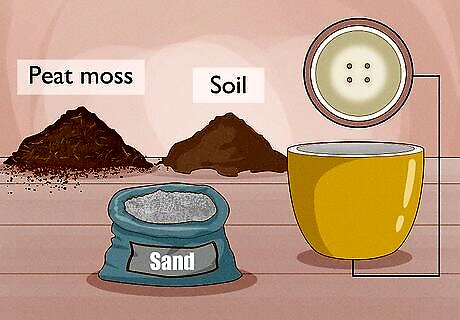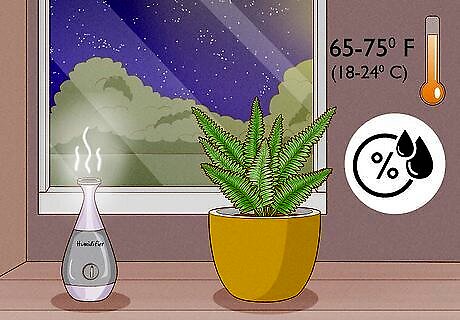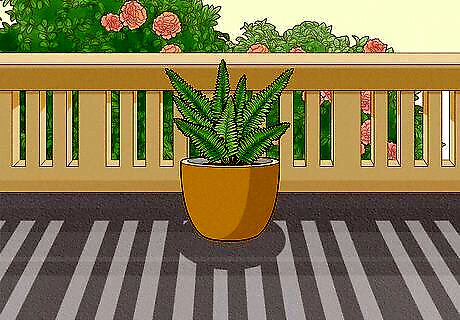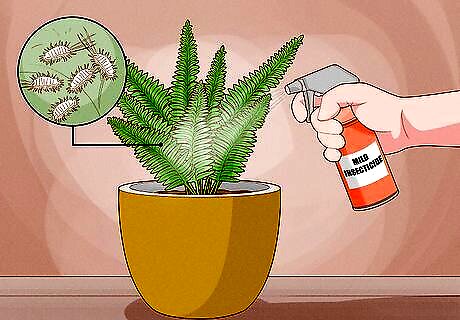
views
Creating the Proper Environment

Gather your potting supplies. Boston ferns will do best in a potting mixture of peat moss, sand, and garden soil. You can buy all of these at your local gardening store. Your final mixture should be even parts of each ingredient. The pot should be big enough for your fern to sit comfortably without it's roots being near the drainage holes, but without a lot of extra space that could accumulate "root rot."

Pot your fern. Put your mixture and plant into the clean pot with drainage holes in the bottom.The fern can be planted about half of the way to the top of the pot so that the roots have space in the soil. Fill in the rest of the pot with more potting mixture, leaving about 1 inch( 25.4 mm) of space from the top.

Place your fern outdoors in a warm, humid environment. In many places, the summers are warm and humid enough to provide the perfect environment for a Boston fern. They do best in environments with humidity levels of at least 50 percent. If your daytime temperatures are between 65 to 75 degrees Fahrenheit (18 to 24 degrees Celsius), and your nighttime temperatures are between 55 and 65 degrees Fahrenheit (13 to 18 degrees Celsius), your Boston ferns will thrive outdoors. You can place them on your porch or patio, and they should do well. The cooler temperatures at night will help to prevent fungus from developing.

Put your Boston fern in an appropriate room indoors. If you are keeping your Boston fern indoors, whether permanently or just for the winter months, you will need to be careful about making sure it has adequate humidity. The very best thing to do is to place it in a room with a humidifier. Keep your house between 65 to 75 degrees Fahrenheit (18 to 24 degrees Celsius), and put it in a cooler room at night. If you don’t want to invest in a humidifier, there are other options. You can place your fern in a saucer filled with small stones and water. The water will create humidity as it evaporates.

Provide your fern with low to moderate indirect sunlight. Boston ferns do best when receiving indirect, filtered sunlight. If they’re outdoors, place them somewhere where they will get sunlight through tree branches, or cracks in a porch roof. If they’re indoors, place them near a window. You don’t want your fern to be in shade, but you don’t want them to be in direct sunlight. It’s a delicate balance.
Keeping Your Fern Healthy

Keep the soil moist. Just like sunlight, you want to provide your Boston fern with enough water, but not too much. Water it with lukewarm water so that the soil is completely damp but not soaked. During warm weather months, you’ll need to water it more frequently. Make sure that the soil is never completely dry. In the wintertime, the fern is not in “growing season.” You can be less vigilant about watering it, and it's actually good to let the soil become dry to the touch before watering again. As new growth appears, start watering the fern more often so that the soil is continuously damp.

Feed your ferns every couple of months. Boston ferns don’t require much, but it is helpful to feed them every two months or so during the warmer time of the year. Purchase houseplant food at your local gardening supply store. Read the instructions on the packaging, and dilute it so that it is half as strong for your fern. During the winter months, you can skip these feedings.

Trim discolored or leafless fronds. Fronds are the branch-like pieces that extend from the plant, covered in leaves. Older leaves may become discolored or lose their leaves, which isn’t the most aesthetically pleasing. Use sharp, clean scissors to remove the fronds all the way at the base. This will allow new, healthy fronds to grow. The best time to prune your Boston fern is in the spring or summer, during growing season.

Protect your fern from insects. Luckily, Boston ferns aren’t typically a target for insects, but they can occasionally attract bugs. Don’t use anything too harsh on your fern. Spray it with a mild insecticide or a natural insect repellant, and observe. Hopefully, this will be all you need to control any potential pests.

Keep your ferns in a dormant state during winter. Fortunately, there are things you can do to ensure that your boston ferns will live through the winter. Once the temperature drops below 40 degrees Fahrenheit (4.4 degrees Celsius), bring your plants inside. It’s okay if they turn brown and shed; this is normal. Water them sparingly once per week and don’t fertilize them at all during this time of year.



















Comments
0 comment